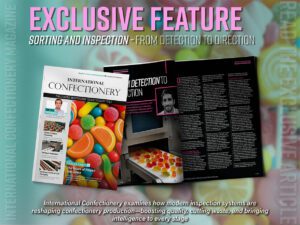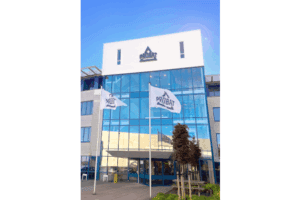Technical Editor Clay Gordon provides a brief but thorough overview of how the coating of confectionery impacts the flavour.
Panned items make up a large portion of the chocolate and sugar confectionery market, and for good reason: it’s an extremely versatile technique that enables the production of a wide range of products – from sugar candy-coated chocolate lentils to chocolate-covered nuts, and more.
And while the technique itself is easy to explain, like most things, being able to produce high quality product consistently – at any scale – requires skill and practice. The same is true for the entire range of cocoa butter-based airbrush, spatter, and other surface decoration techniques used in chocolate bonbon production
Behind these seemingly simple ideas lies a complex set of interdependencies as the finished panned product is built up, layer by layer, from the centre out and the bonbon is built up layer by layer from the outside in.
I’ve covered some of these layers in previous issues of International Confectionery. In the October 2021 issue I took a look at one of the questions I get asked most when it comes to panning, which is about vegan options for coating, polishing and glazing. For the May 2022 issue I explored colourings and flavourings that can be used in sugar or chocolate work.
For this issue the focus is on gaining a better understanding of some nuances in the vocabulary of colour as it is used in food production. This understanding will be helpful when visiting a vendor’s website where you will encounter a wide range of terms you may be familiar with.
Familiar, at least, in the sense that you’ve seen the words before – perhaps on an ingredient label – but you may never have stopped to think what they actually imply and mean. For example, what is a “lake” pigment and how does it differ from a “great” lake? What does “natural” mean in when it comes to food colours? From a food safety perspective, what is the difference between being non-toxic and edible? What does FD&C mean? What are the implications – if any – for pigments that may be suitable for use in the US but not in Europe? Finally, what the heck is up when it comes to the status of titanium dioxide (TiO2)?
A dye is a colouring agent – a pigment – that is water-soluble, completely dissolving, thereby changing the colour of the water.
An FD&C “lake” colouring is made by chemically binding a water-soluble dye to a particle of a metal salt. This process is known as “laking” and is derived from the word lac. The end result is a coloured particle that is no longer water soluble; laked particles are dispersed (suspended) in water. A “great lake” is the fat-based version of a lake – the pigment is chemically bound to a small carrier particle that can be suspended in a fat or oil...
To read more see our latest issue here.
Media contact
Caitlin Gittins
Editor, International Confectionery
Tel: +44 (0) 1622 823 920
Email: [email protected]








